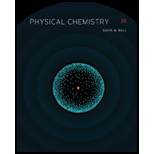
Concept explainers
(a)
Interpretation:
The osmotic pressure at
Concept introduction:
Osmotic pressure is defined as the minimum pressure applied on the solution to stop the flow of solvent molecules through the semi-permeable membrane.
Osmotic pressure is the colligative property and depends on the number of atoms of particle of the substance present in material.
Answer to Problem 7.85E
The osmotic pressure of the given solution is
Explanation of Solution
Given temperature
The mole fraction of
Where,
•
Substitute the values of number of moles of each component in the above formula.
The mole fraction of component
On complete dissociation of
The osmotic pressure of the solution is given as,
Where,
•
•
•
Substitute the value of
The osmotic pressure of the given solution is
The osmotic pressure of the given solution is
(b)
Interpretation:
The osmotic pressure at
Concept introduction:
Osmotic pressure is defined as the minimum pressure applied on the solution to stop the flow of solvent molecules through the semi-permeable membrane.
Osmotic pressure is the colligative property and depends on the number of atoms of particle of the substance present in material.
Answer to Problem 7.85E
The osmotic pressure of the given solution is
Explanation of Solution
Given temperature
The mole fraction of
Where,
•
Substitute the values of number of moles of each component in the above formula.
The mole fraction of component
On complete dissociation of
The osmotic pressure of the solution is given as,
Where,
•
•
•
Substitute the value of
The osmotic pressure of the given solution is
The osmotic pressure of the given solution is
(c)
Interpretation:
The osmotic pressure at
Concept introduction:
Osmotic pressure is defined as the minimum pressure applied on the solution to stop the flow of solvent molecules through the semi-permeable membrane.
Osmotic pressure is the colligative property and depends on the number of atoms of particle of the substance present in material.
Answer to Problem 7.85E
The osmotic pressure of the given solution is
Explanation of Solution
Given temperature
The mole fraction of
Where,
•
Substitute the values of number of moles of each component in the above formula.
The mole fraction of component
On complete dissociation of
The osmotic pressure of the solution is given as,
Where,
•
•
•
Substitute the value of
The osmotic pressure of the given solution is
The osmotic pressure of the given solution is
Want to see more full solutions like this?
Chapter 7 Solutions
PHYSICAL CHEMISTRY-STUDENT SOLN.MAN.
- What is the total energy cost associated with the compound below adopting the shown conformation? CH3 HH DH CH3arrow_forwardΗΝ, Draw Final Product C cyclohexanone pH 4-5 Edit Enamine H3O+ CH3CH2Br THF, reflux H Edit Iminium Ionarrow_forwardHow many hydrogen atoms are connected to the indicated carbon atom?arrow_forward
- Identify the compound with the longest carbon - nitrogen bond. O CH3CH2CH=NH O CH3CH2NH2 CH3CH2C=N CH3CH=NCH 3 The length of all the carbon-nitrogen bonds are the samearrow_forwardIdentify any polar covalent bonds in epichlorohydrin with S+ and 8- symbols in the appropriate locations. Choose the correct answer below. Η H's+ 6Η Η Η Η Η Ηδ Η Ο Ο HH +Η Η +Η Η Η -8+ CIarrow_forwardH H:O::::H H H HH H::O:D:D:H HH HH H:O:D:D:H .. HH H:O:D:D:H H H Select the correct Lewis dot structure for the following compound: CH3CH2OHarrow_forward
- Rank the following compounds in order of decreasing boiling point. ннннн -С-С-Н . н-с- ННННН H ΗΤΗ НННН TTTĪ н-с-с-с-с-о-н НННН НН C' Н н-с-с-с-с-н НН || Ш НННН H-C-C-C-C-N-H ННННН IVarrow_forwardRank the following compounds in order of decreasing dipole moment. |>||>||| ||>|||>| |>|||>|| |||>||>| O ||>>||| H F H F H c=c || H c=c F F IIIarrow_forwardchoose the description that best describes the geometry for the following charged species ch3-arrow_forward
- Why isn't the ketone in this compound converted to an acetal or hemiacetal by the alcohol and acid?arrow_forwardWhat is the approximate bond angle around the nitrogen atom? HNH H Harrow_forwardOH 1. NaOCH2CH3 Q 2. CH3CH2Br (1 equiv) H3O+ Select to Draw 1. NaOCH2 CH3 2. CH3Br (1 equiv) heat Select to Edit Select to Drawarrow_forward
 Introduction to General, Organic and BiochemistryChemistryISBN:9781285869759Author:Frederick A. Bettelheim, William H. Brown, Mary K. Campbell, Shawn O. Farrell, Omar TorresPublisher:Cengage Learning
Introduction to General, Organic and BiochemistryChemistryISBN:9781285869759Author:Frederick A. Bettelheim, William H. Brown, Mary K. Campbell, Shawn O. Farrell, Omar TorresPublisher:Cengage Learning Chemistry: Principles and ReactionsChemistryISBN:9781305079373Author:William L. Masterton, Cecile N. HurleyPublisher:Cengage Learning
Chemistry: Principles and ReactionsChemistryISBN:9781305079373Author:William L. Masterton, Cecile N. HurleyPublisher:Cengage Learning Chemistry: The Molecular ScienceChemistryISBN:9781285199047Author:John W. Moore, Conrad L. StanitskiPublisher:Cengage Learning
Chemistry: The Molecular ScienceChemistryISBN:9781285199047Author:John W. Moore, Conrad L. StanitskiPublisher:Cengage Learning General, Organic, and Biological ChemistryChemistryISBN:9781285853918Author:H. Stephen StokerPublisher:Cengage Learning
General, Organic, and Biological ChemistryChemistryISBN:9781285853918Author:H. Stephen StokerPublisher:Cengage Learning Chemistry: Principles and PracticeChemistryISBN:9780534420123Author:Daniel L. Reger, Scott R. Goode, David W. Ball, Edward MercerPublisher:Cengage Learning
Chemistry: Principles and PracticeChemistryISBN:9780534420123Author:Daniel L. Reger, Scott R. Goode, David W. Ball, Edward MercerPublisher:Cengage Learning Chemistry & Chemical ReactivityChemistryISBN:9781337399074Author:John C. Kotz, Paul M. Treichel, John Townsend, David TreichelPublisher:Cengage Learning
Chemistry & Chemical ReactivityChemistryISBN:9781337399074Author:John C. Kotz, Paul M. Treichel, John Townsend, David TreichelPublisher:Cengage Learning





